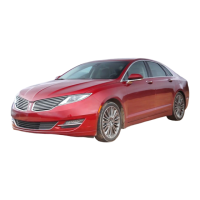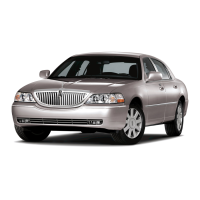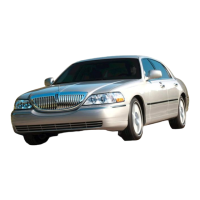
Do you have a question about the Lincoln 2011 MKZ Hybrid and is the answer not in the manual?
| Brand | Lincoln |
|---|---|
| Model | 2011 MKZ Hybrid |
| Category | Automobile |
| Language | English |
Alerts you to vehicle conditions that may require extensive repairs. Many lights illuminate briefly at startup.
Illuminates when ignition is on to check bulb. Blinking indicates engine misfire, potentially damaging the catalytic converter.
Illuminates momentarily at ignition on or when parking brake is applied. Indicates low fluid or system malfunction.
Illuminates or flashes if a malfunction is detected. Normal braking is functional unless brake warning light is also on.
Indicates braking system malfunction or low brake fluid level. A message may display in the message center.
Illuminates momentarily when ignition is turned on. If light fails to illuminate, flashes, or remains on, contact dealer.
Displays important vehicle information and system warnings through constant monitoring of vehicle systems.
Information on the AM/FM in-dash CD6/MP3 satellite compatible Lincoln premium sound/THX audio system.
Operation of the DATC system, including fan speed, defrost, manual override, and A/C controls.
Climate controls via touchscreen, including temperature, heated/cooled seats, A/C, and defroster.
Information on lamp assembly condensation and using the correct bulbs.
Controls windshield wipers and rain-sensing wipers.
Details on using power outlets for accessory plugs, capacity limits, and fuse protection.
Instructions for operating power windows, including one-touch and global open features.
Instructions on using speed control, setting, disengaging, and resuming speed.
Controls for radio and SYNC system, including volume, seek, media, and voice commands.
Information on Integrated Keyhead Transmitters (IKTs) and key blade functions.
Feature to program restricted driving modes, with standard and optional settings.
Details on the engine immobilization system and its components.
Information on replacing and programming integrated keyhead transmitters and coded keys.
Procedure to program your own integrated keyhead transmitters or standard SecuriLock coded keys.
Warnings about seatback reclining, cargo height, and proper seatback latching.
Warnings and instructions for adjusting the driver's seat and seatback.
System for automatic positioning of driver seat and mirrors to two programmable positions.
Operation of heated and cooled seats, with warnings for prolonged use.
Overview of the Personal Safety System, including airbags and seat belts.
Explanation of how the Personal Safety System adapts deployment based on crash severity and occupant conditions.
Tailors airbag inflation energy based on common and severe impacts.
Detects occupant presence and position to enable or disable front passenger frontal airbag.
Emphasizes proper restraint for children and warnings about airbags.
Explains how sensors initiate pretensioner activation and airbag inflation.
Warnings about objects near airbag covers, accessory seat covers, and leaning on doors.
Indicates system status via readiness light or tone, and what to do if difficulty is indicated.
Warnings about objects in deployment zones, leaning on doors, and system modification.
Explains the inflatable curtain, gas generator, and crash sensors for side airbags.
Important precautions for securing children, including proper restraint devices and vehicle compatibility.
Steps for installing child seats using vehicle safety belts, including proper buckle use and automatic locking mode.
Explains the purpose of booster seats and when children should use them.
Instructions for inspecting and maintaining vehicle safety belts and child seat systems.
Guidelines for safe tire inflation, daily checks, and monthly inspections.
Emphasizes using only recommended replacement tires and wheels for safety.
Explains the TPMS, low tire pressure telltale, and malfunction indicator.
How TPMS measures pressure, low tire pressure warning, and temporary spare tire installation.
Guidance on proper loading to keep vehicle weight within design rating capacity.
Warning against towing a trailer with this vehicle as it is not equipped.
Positions of the ignition key and preparing to start your vehicle.
Warnings about extended idling, parking in grass, closed garages, and exhaust fumes.
System controls engine idle RPM, ensures safety belts are buckled, and accessories are off.
Step-by-step guide to starting the vehicle, including the Ready Indicator Light.
Precautions to avoid dangerous effects of carbon monoxide in exhaust fumes.
Information on brake noise, inspection, and the brake system warning light.
How ABS helps maintain steering control during emergency stops by preventing wheel lockup.
Illuminates momentarily at ignition on. If it doesn't illuminate, stays on, or flashes, ABS may need service.
Proper ABS braking technique: continuous force on pedal, do not pump.
Simulates engine braking, recovers energy, and stores it in the battery for fuel economy.
Features like Traction Control (TCS) and Electronic Stability Control (ESC) for driving situations.
Enhances directional stability during adverse maneuvers by applying brakes and reducing engine power.
Feature preventing gearshift lever movement from Park unless brake pedal is pressed.
Understanding the gearshift positions: P, R, N, D, and L.
Sounds a tone to warn of obstacles near rear bumper when backing.
Provides a video image behind the vehicle for assistance while reversing.
Alerts driver to vehicles in blind zones and approaching vehicles when backing.
Precautions for driving through deep or standing water, and drying brakes afterward.
Overview of complimentary roadside assistance program services.
Procedure for changing a flat tire, noting TPMS sensor care.
Detailed steps for safely changing a tire, including warnings about jack usage.
Safety warnings and procedures for jump starting the vehicle's 12-volt battery.
How to inform NHTSA and Ford Motor Company about potential safety defects.
How to inform Transport Canada about potential safety defects.
Safety precautions for working on the vehicle, including hot engines and moving parts.
Warnings about severe personal injury or death from high voltage components.
Instructions for checking engine oil level and adding oil if necessary.
Instructions for adding engine coolant, with warnings about hot systems and mixing coolants.
Important safety precautions when handling automotive fuel.
Recommendations for using UNLEADED fuel and avoiding fuel additives.
Ensuring proper operation of emission control components and catalytic converter.
How the OBD-II system monitors emission controls and detects malfunctions.
Powerful protection backed by Ford Motor Company beyond the New Vehicle Limited Warranty.
Protection and benefits of Ford ESP in Canada, including rental reimbursement and roadside assistance.












